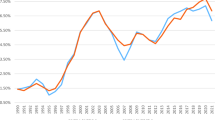Abstract
In the aftermath of the global financial crisis, much attention has been paid to investigating the appropriateness of the current practice of default risk modeling in banking, finance and insurance industries. A recent empirical study by Guo et al. (Rev Deriv Res 11(3): 171–204, 2008) shows that the time difference between the economic and recorded default dates has a significant impact on recovery rate estimates. Guo et al. (http://arxiv.org/abs/1012.0843, 2011) develop a theoretical structural firm asset value model for a firm default process that embeds the distinction of these two default times. In this paper, we assume the market participants cannot observe the firm asset value directly and we develop reduced-form models for characterizing the economic and recorded default times. We derive the probability distributions of these two default times. Numerical experiments with empirical data are given to demonstrate the proposed models. Our approach helps researchers to gain a new perspective for economic and recorded defaults and is more feasible in general practice compared with current method. Our results can also contribute to the understanding of the impacts of various parameters on the economic and recorded default times.





Similar content being viewed by others
References
Baeka, J., Kangb, J., & Park, K. (2004). Corporate governance and firm value: Evidence from the Korean financial crisis. Journal of Financial Economics, 71, 265–313.
Black, F., & Scholes, M. (1973). The pricing of options and corporate liabilities. Journal of Political Economy, 81(3), 637–654.
Ching, W., Siu, T., Li, L., Li, T., & Li, W. (2009). Modeling default data via an interactive hidden Markov model. Computational Economics, 34(1), 1–19.
Duffie, D., & Garleanu, N. (2001). Risk and valuation of collateralized debt obligations. Financial Analysts Journal, 57(1), 41–59.
Duffie, D., & Kan, R. (1996). A yield-factor model of interest rates. Mathematical Finance, 6(4), 379–406.
Guo, X., Jarrow, R., & Lin, H. (2008). Distressed debt prices and recovery rate estimation. Review of Derivatives Research, 11(3), 171–204.
Guo, X., Jarrow, R., & de Larrard, A. (2011). Economic default time and the Arcsine law, working paper, 2011, available at: http://arxiv.org/abs/1012.0843
Ivashina, V., & Scharfstein, D. (2010). Bank lending during the financial crisis of 2008. Journal of Financial Economics, 97, 319–338.
Jacobson, T., Linde, J., & Roszbach, K. (2011). Firm default and aggregate fluctuations, Board of Governors of the Federal Reserve System, International Finance Discussion Papers, number 1029, working paper, 2011.
Jarrow, R., & Turnbull, S. (1995). Pricing derivatives on financial securities subject to credit risk. Journal of Finance, 50, 53–86.
Lando, D. (1998). On Cox processes and credit risky securities. Review of Derivatives Research, 2, 99–120.
Madan, D., & Unal, H. (1998). Pricing the risks of default. Review of Derivatives Research, 2(2–3), 121–160.
Merton, R. C. (1974). On the pricing of corporate debt: The risk structure of interest rates. Journal of Finance, 29(2), 449–470.
Wu, J., & Yang, W. (2013). Valuation of synthetic CDOs with affine jump-diffusion processes involving Levy stable distributions. Mathematical and Computer Modelling, 57, 570–583.
Acknowledgments
The authors would like to thank the referees and the editor for their helpful comments and suggestions. This research work was supported by Research Grants Council of Hong Kong under Grant No. 17301214 and HKU CERG Grants and Hung Hing Ying Physical Research Grant.
Author information
Authors and Affiliations
Corresponding author
Appendix
Appendix
1.1 Appendix 1: Proof of Proposition 2
We note that Eq. (2) follows from Eq. (1) by using
Eq. (3) follows from Eq. (1) by using
And Eq. (1) follows by
1.2 Appendix 2.1: Proof of Proposition 3
Proof
Eq.s (12) and (13) are obvious and it suffices to show Eq. (11). Now we have
Hence
For a fixed \(\mathbf{e} \in \hat{E}_i\), let
Then we can rewrite \(\hat{\mu }(\mathbf{e}, s)\) as
Using the iterated expectation and Eq. (10) we obtain
Hence Eq. (11) follows. \(\square \)
1.3 Appendix 2.2: Proof of Proposition 4
Proof
We let
then by the proof of Proposition 3, for \(i\ge 1\),
By Proposition 3, we obtain that
Combining Eqs. (16) and (10), Proposition 4 follows. \(\square \)
1.4 Appendix 3
Let \(\delta =18\) days, \(t_i=\delta i, i=0, 1, \ldots , 10\). Let \(N_i\) denote the number of firms whose time difference of economic and recorded default date is inside the interval \((t_{i-1}, t_i]\). Then the log-likelihood function is given by
By setting
we have two nonlinear equations for \(\lambda _1\) and \(\lambda _2\). Solving these equations numerically yields \(\lambda _1=0.3631\) and \(\lambda _2=0.0238\).
Rights and permissions
About this article
Cite this article
Gu, JW., Jiang, B., Ching, WK. et al. On Modeling Economic Default Time: A Reduced-Form Model Approach. Comput Econ 47, 157–177 (2016). https://doi.org/10.1007/s10614-014-9469-0
Accepted:
Published:
Issue Date:
DOI: https://doi.org/10.1007/s10614-014-9469-0




